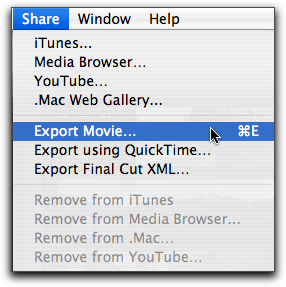
After about the millionth preview, you’ll probably come to the realization that your movie will never be perfect: If you don’t just give up and release your movie, it will never be seen by anyone. Star Wars creator George Lucas once described this process as one of abandonment because most moviemakers almost never feel that a project is truly finished. When you decide that it’s time to “abandon” your project, you must export the movie so that others can view it. Before you export your movie, you must decide in which format you wish to export. After you’ve edited your movie in a program like Studio or iMovie, you aren’t limited to showing your work to others on your computer. You have many options with which to share your movie:
- Videotape: Almost everyone you know probably has a VCR that plays VHS tapes. Sure, the quality and gee-whiz factor of VHS tapes isn’t as high as DVD, but most of your audience really won’t care. If you have an analog capture card such as a Pinnacle AV/DV board, you can connect a VCR directly to your computer and export your movie directly to a VHS tape. Otherwise export the movie back to a tape in your digital camcorder, and then dub the movie from the camcorder tape to a VCR
- DVD: The DVD (Digital Versatile Disc) player is quickly supplanting the VCR as the home video player of choice for many people. Tens of millions of households already have DVD players in their home entertainment systems, and many modern computers can play DVD movies as well. DVD recorders are now relatively affordable, so making your own DVDs is pretty easy..
- VCD/S-VCD: If you don’t have a DVD burner yet, you can make DVD-like movie discs called VCDs (Video Compact Discs) or S-VCDs (Super VCDs) using a regular CD-R drive and blank CDs. VCDs can hold about one hour of video, and S-VCDs hold 20 minutes of higher quality video. VCDs and S-VCDs can be played in most DVD players.
- Internet: The Internet is a popular place to share video, but remember that video files are usually very big and most people still have relatively slow Internet connections. If you plan to export your movie for use on the Internet, use a Web-friendly format such as Apple QuickTime, RealNetworks RealVideo, or Windows Media Video. These formats usually have fairly low quality, but the trade-off is much smaller file sizes. When choosing one of these formats, make sure that your intended audience has software that can play your movies.
- Video file: Some programs allow you to simply save the movie as a file. Common video file formats include AVI and MPEG. These files can be stored on your computer, or burned onto a CD so that others can watch your movie on their computers as well. Just remember that the AVI and MPEG formats are generally too big for anyone but broadband users to access online. AVI or MPEG files are useful, however, if you plan to edit the movie further using another editing program.








